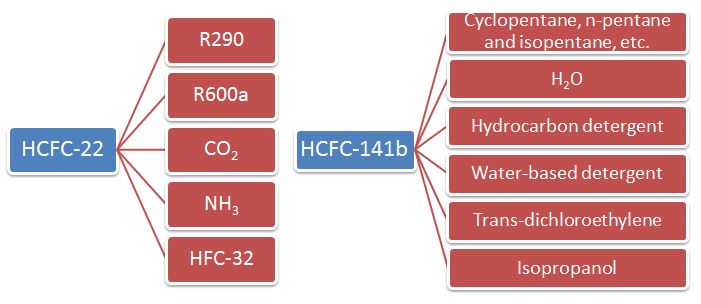On June 5, China’s Ministry of
Environmental Protection released a list of thirteen substitute refrigerants,
detergents and foaming agents it plans to support during China’s transition
away from HCFCs. The list featured ten natural substances and only one HFC.
The
First Catalogue of Recommended Substitutes for HCFCs does
not include any practical policy measures and is merely supposed to serve as a
general statement of intent by the government, but more substantial reforms are
sure to follow.
CCM spoke to a number of insiders
in China’s air conditioning and refrigerant industries in the wake of the
publication of the Catalogue to get a
sense of the mood in the two industries and how companies plan to move forward.
Figure
1: Recommended substitutes for HCFCs listed by China’s Ministry of
Environmental Protection

Source:
CCM
The
start of something big
All the insiders CCM spoke to are
under no illusions as to the Catalogue’s significance. All agreed that the Catalogue is almost certainly the
prelude to a government campaign to promote natural refrigerants at the expense
of HFCs.
As with China’s previous drive to
support R290 air conditioners, policy measures that are likely to follow
include subsidies to help producers overhaul their production lines, price
subsidies for products containing natural refrigerants and support in promoting
these products.
However, there was a general
consensus that the HFC industry is unlikely to be affected for at least the
next 1-2 years as it will take time for these policies to be implemented.
Air
conditioner manufacturers: playing it by ear
The attitude among air conditioner
manufacturers is generally one of reluctant compliance. The government has been
promoting R290 in recent years, but Chinese consumers have shown little
enthusiasm for paying extra for these more environmentally-friendly products.
As a result, manufacturers have little incentive to invest in expanding
production of R290 without further government incentives.
“We officially launched R290 air
conditioners in H1 2015, as the government has offered to support R290 as a
substitute for difluorochloromethane (HCFC-22) in household air conditioners
since 2011. Many supporting policies have been issued, covering production,
application, promotion and sale,” said an engineer from Gree Electric
Appliances.
“But we have kept production small
because the HCFC-22 and HFC-410a (a 1:1 mixture of difluoromethane – HFC-32 and
pentafluoroethane – HFC-125) air conditioners still play a vital role in the
market, with 80%+ sales in total, whilst the rest is partially claimed by
HFC-32 air conditioners. R290 air conditioners still account for a small share.”
However, Gree Electrical Appliances
received its first order for R290 air conditioners from a public institution in
June – an order from Shenzhen University for 243 units. If the company starts
to receive more of these government contracts, it may be tempted to expand
production further.
Fluorine-enriched
refrigerant producers: looking to make hay while the sun shines
Chinese producers of HCFC and HFC
refrigerants recognize that the tide is beginning to turn away from them, but
most of them remain bullish about their prospects for the immediate future.
A representative of Zhejiang Sanmei
Chemicals underlined this point by pointing out that his company’s sales of HFC-134a
aerosol cans (net weight: 200-250 g/can) during the first half of 2015 were up
over 70% year on year. Zhejiang Sanmei Chemicals is still the market leader in
vehicle air conditioner refrigerants and it expects HFCs will continue to
dominate this market for some time to come.
Sinochem Lantian, a subsidiary of
Sinochem Group that specializes in fluorine chemicals, also expects sales of
HFCs to continue growing unless practical policies are introduced to promote
natural refrigerants:
“HFCs, mainstream substitutes for
HCFCs, have already been applied widely”, said a sales manager from the
company. “Now the vehicle air conditioning segment, as a whole, has adopted
1,1,1,2-tetrafluoroethane (HFC-134a); in the domestic air conditioning sector,
the proportion of HFC-410a air conditioners has been increasing, now equal to
that of traditional HCFC-22 ones”.
The sales manager attributed the
government’s support for natural refrigerants to the EU’s new F-Gas Regulations, which will gradually
phase out the use of HFCs over the next fifteen years. However, China has not
yet introduced similar restrictions on the HFC industry, and natural
refrigerants will struggle to compete until it does so.
However, despite the brave face the
industry is putting on, there is sure to be widespread concern about the
long-term future of HFCs in China.
Many manufacturers are already
struggling due to the severe overcapacity in the industry, with operating rates
among producers of HFC-134a, HFC-410a, HFC-32 and HFC-125, all under 60%. Prices have also
fallen dramatically as a result – in the case of HFC-134a, prices have
plummeted 300% from 2010-2012 levels.
The only route out of this overcapacity crisis is through increasing
demand for HFCs, but the government’s evangelizing of natural refrigerants
threatens to make this impossible.
For now, it is a case of ‘keep calm
and carry on’ for both air conditioner and refrigerant companies, but both
groups will be keeping a close eye on the government as they wait for its next
move.
CCM
is the leading provider of market intelligence on China’s chemicals market. For
more information about CCM and its coverage of refrigerants in China, please
visit www.cnchemicals.com or get in touch directly by
emailing econtact@cnchemicals.com or calling +86-20-37616606.